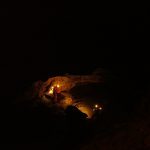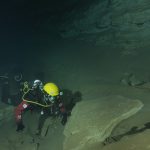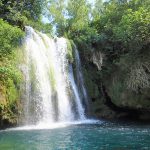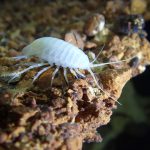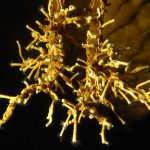The olm
The olm, the only stygobiont species that inhabits the karst region of Croatia, is likely the best known subterranean resident.
It is the only true subterranean vertebrate, a paleoendemic species (living fossil) of the Dinarides mountain range, and is completely adapted to life in cave conditions. It inhabits the karst underground areas in northern Italy, Slovenia, Croatia and Bosnia and Herzegovina. In Croatia, it was first recorded in 1840 at the Goručica spring near Sinj.
Due to the cold and scarcity of food in the cave habitats it is found in, this amphibian species reaches sexual maturity still in the larval phase, and remains in this phase its entire life (neoteny). Behind the head, there are three pairs of pinkish to bright red external gills on the neck, a characteristic of the larval stage of tailed amphibians. Since it never completes metamorphosis and enters the adult stage, like most other amphibians, the olm lives its entire life as an aquatic organism.
The base colour of the body is white, with a pinkish tinge (due to the capillaries right under the surface), and due to its similarity with human skin, in Croatia this species is called the “man fish”. Due to living in conditions of constant darkness, the eyes are only visible in young individuals, while adults have tiny eyes covered in a thin layer of skin and are not visible. Only one olm population, in Bela Krajina in Slovenia, have a dark grey skin colouration and visible eyes. The body is slender and elongated, from 25 – 35 cm (max 40 cm) from the tip of the snout to the tip of the tail. Since it very rarely leaves the water, the legs are small, with three toes on the forelegs and two toes on the hind legs, that serve only for minimal movements in seeking food. The tail is laterally flattened, exceptionally strong, and serves for movement through the water. In oxygen rich waters, it breathes through the gills and through the skin, while in hypoxic conditions it can also breathe with its lungs. It feeds on aquatic cave invertebrates, such as crustaceans, snails and insect larvae, and can live up to eight years without food. The olm is a small tailed amphibian, and weighs 15–20 grams. Its development is very slow, and it reaches adulthood after 14–18 years. Since it can live for over 100 years (68.5 years in captivity), the olm is the longest-living amphibian. It prefers clean, oxygen rich waters and relatively low temperatures, from 5 to 15°C. It is usually found in the deep part of caves, and may occasionally be found in shallow underwater lakes in search of food. During high spring rains, individuals may be forced out of the underground with the rushing water through karst springs and estavelles.
It usually lives in small groups. During mating, the males become exceptionally territorial. When a female enters into a male’s territory, the courtship begins. During courting, the male attracts the female by releasing hormones into the water, waving its tail to direct them towards her head. The courting ritual reaches its climax when the male lays a packet of sperm (spermatophore) on the surface, which the female then picks up with her cloaca, resulting in internal fertilisation of eggs. Courting can be repeated multiple times over several hours. When she leaves the male’s territory, the female seeks out an adequate place to lay her eggs. After 2–3 days, she begins to lay the eggs under rocks and continues to guard them until the young larvae hatch. She repeats this for 25 days, and can lay more than 70 eggs, giving rise to the next generation of larvae. The eggs are round, white, about 5–6 mm long. The incubation period varies and depends largely on temperature (at 15°C lasts about 85 days).
In Croatia, the olm inhabits caves and sinkholes of karst fields, from Istria to Dubrovnik. There are three separate populations that inhabit the regions of Istria, Gorski Kotar and the Gacko Polje field (northern Lika), and Dalmatia (from the Krka River to Dubrovnik). It is interesting that in the area of the Lika Polja field, Mt. Velebit and Zrmanja River, it has never been recorded (this is assumed to be due to a hydrogeological barrier). The olm population in Istria has been confirmed through genetic research to be a separate species – the Istrian olm. In Croatia, the olm is a strictly protected species, and at the European level it is considered a priority species and listed in the Annexes of the EU Habitats Directive. It has also been included on the list of the EDGE Conservation programme, aimed at protecting and conserving threatened species that are unique in their evolution and that are irreplaceable parts of the world natural heritage.
Despite protection at the national and European levels, this species was assessed to fall within the category of endangered species in the most recent assessment of threats to amphibians and reptiles in Croatia. The basic cause of its threat is the degradation of karst habitats due to the pollution of ground waters, and works that alter the hydrological region of ground waters.
The olm was discovered in Krka National Park in 1989. Monitoring of the species in the park area has shown that this population is stable.
Photo: Branko Jalžić



